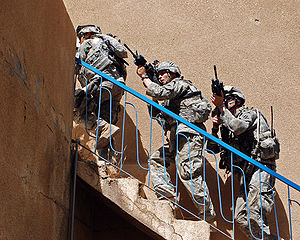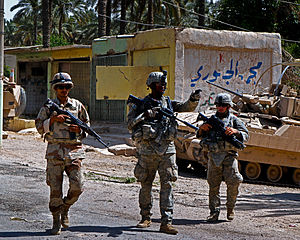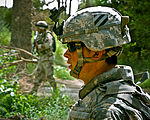- Operation Marne Torch
-
Operation Marne Torch Part of the Iraq War (Operation Phantom Thunder)
Soldiers from 1-30 Infantry, 2nd Brigade Combat Team, 3rd Infantry Division, storm one of the thousands of structures that was cleared during Operation Marne Torch.Date June 16, 2007 - August 14, 2007 (Marne Torch 1)
September 15, 2007 - October 14, 2007 (Marne Torch II)Location Babil Province, Iraq Result U.S. military raids successful;
Disruption of insurgent supply lines;
Holding operations delayedBelligerents  United States
United States
 New Iraqi Army
New Iraqi ArmyIraqi Insurgency
 Al-Qaeda in Iraq
Al-Qaeda in IraqCommanders and leaders  General Rick Lynch (Task Force Marne)
General Rick Lynch (Task Force Marne)
 Colonel Terry Ferrell (2-3BCT)
Colonel Terry Ferrell (2-3BCT)
 Colonel Wayne W. Grigsby Jr. (3-3HBCT)
Colonel Wayne W. Grigsby Jr. (3-3HBCT)Strength 3000 (2000 Coalition, 1000 Iraqi) [1] Unknown Casualties and losses 13 killed (U.S.),
3 killed (Iraqi security forces),
1 OH-58 Kiowa shot down88 killed, 278 detained[2] Operation Marne Torch refers to two operations launched by Coalition forces in 2007 against al-Qaeda in Iraq in the Arab Jabour area of Babil province. This campaign is named after Operation Torch, the joint US/British invasion of French North Africa in 1942,[3] presumably because of the two operations' similar thrust in to the enemies southern underbelly.
The first operation, Marne Torch I began on June 16, 2007, when Multi-National Division-Central launched offensive operations against Sunni and Shi'ia extremists, as well as insurgents with Iranian influence in the city and surrounding regions of Arab Jabour in Babil province.[4] The action was intended to clear terrorist sanctuaries southeast of Baghdad as well as reduce the flow of accelerants into that city by both combat and civil-military operations.[4] 2000 coalition and 1000 Iraqi army soldiers disrupted insurgent operations by capturing, seizing, and clearing caches that support instability in the area.[5]
Marne Torch II was launched on September 15, 2007 in the Hawr Rajab area. Supported by a newly created Sons Of Iraq group from Arab Jabour, Coalition forces continued their push along the west bank of the Tigris river, killing or capturing 250 insurgents, destroying 12 boats being used by the insurgents to funnel weapons into Baghdad, and uncovering 40 weapons caches, often with tips from the Sons of Iraq.[1]
Contents
Background
The 2nd BCT of the 3rd infantry division was the 20th and last of the "Surge" brigades to arrive in Iraq. Their mission was to clear and hold the Arab Jabour area to the south-east of Baghdad, through which insurgents had been supplying forces in Baghdad. Coalition forces adopted a new counter insurgency strategy of moving out of forward operating bases and living with the population, to provide security and gain more useful intelligence.
Units Involved
- US forces reported to be involved were
- 2nd Brigade Combat Team, 3rd Infantry Division
- 3rd Brigade Combat Team, 3rd Infantry Division
- 3rd Combat Aviation Brigade, 3rd Infantry Division
- 4th Brigade Combat Team, 25th Infantry Division
- Support services were provided by the 82nd Sustainment Brigade.
Marne Torch I
As part of the much vaunted "troop surge" in the summer of 2007, MND-C initiated Operation Marne Torch I on June 15, 2007. Consisting of both kinetic and non-kinetic operations, Marne Torch I was launched to establish a security presence on both sides of the Tigris River valley, an area that had not seen a large coalition presence and was under insurgent control. According to MND-C Commander Maj. Gen. Rick Lynch the operation sought specifically to "block accelerants of violence into Baghdad, secure the population and defeat sectarian violence." Lynch said "Accelerants are defined as anything -- insurgents, weapons, materiel, IEDs, VBIEDs, ideology, anything -- that, left uncontrolled, would affect the security in Baghdad."[6] While being intelligence-driven, Marne Torch had three primary characteristics:
- Speed - Coalition ground units would secure insurgent-held areas and quickly transition to a hold strategy.
- Violence - The insurgency would be struck efficiently and with overwhelming firepower, on the ground and from the air.
- Engagement - US and Iraqi forces would solicit cooperation from the populace by restoring and improving the local infrastructure.[6]
During this phase, more than 1,100 structures were cleared, 83 insurgents killed, and more than 850 citizens were entered into a biometric identification system. However, Coalition forces failed to transition to a holding strategy as the insurgent network proved too entrenched and Iraqi security forces too immature.[7]
American air power was used extensively during Marne Torch I. During the operation more than 70 air strikes were conducted, including attacks by US Air Force B-1B bomber [8] and F-16C strike aircraft,[9] as well as US Navy F/A-18E Hornets. The new XM982 Excalibur satellite-guided artillery round was also utilized with particularly devastating effect, targeting insurgent leaders hiding among the local populace.[4] One example of this particular weapon system being effectively employed, in conjunction with fluid coordination between other American air support assets, occurred on July 14.[10]
Coalition forces received intelligence reports that Al-Qaeda in Iraq cell leader Abu Jurah and 14 insurgents were meeting at a house in Arab Jabour. The cell was reported to be responsible for IED, VBIED, and indirect fire attacks on Coalition forces. Predicated upon this belief, American commanders went after Jurah with a vengeance. At 1312 zulu time, the meeting house was positively identified. Two XM982 Excalibur rounds were fired from a M109 Paladin 155mm battery based at Camp Falcon and placed on the house, destroying it.[11] A Predator UAV orbiting overhead observed personnel leaving the rubble of the meeting house, loading wounded persons in to a sedan and driving away. An AH-64 Apache helicopter gunship arrived over the area and promptly destroyed the sedan. Three more personnel were observed running from the remnants of the meeting house into a nearby structure.
A US Air Force F-16 reported on station and dropped two 500-pound GPS-guided bombs on the structure. A bomb damage assessment confirmed Jurah's death.[12]
Soldiers on the ground also had the advantage of ubiquitous OH-58D Kiowas patrolling the sky, providing near-instantaneous visual reconnaissance and fire support. The 3rd Combat Aviation Brigade which operated the Kiowas was responsible for over 70% of insurgent casualties[1]
On July 2 an insurgent leader on the most wanted list was captured in Arab Jabour.
In mid-July, MND-C transitioned to Operation Marne Avalanche[7]
Marne Torch II
Marne Torch II
was launched on September 15, 2007 in the Hawr Rajab area. Supported by 700 Iraqis from the newly created Sons Of Iraq group from Arab Jabour, Coalition forces continued their push along the west bank of the Tigris river, killing or capturing 250 insurgents, destroying 12 boats being used by the insurgents to funnel weapons into Baghdad and uncovering 40 weapons caches, often with tips from the Sons of Iraq.[1]
Coalition forces also established new patrol bases in Arab Jabour, which allowed them to push further south into insurgent sanctuaries in future operations as well as allow Iraqis to feel secure enough to come forward and volunteer for the awakening movements.[1]
See also
- The New Way Forward
- Operation Fardh al-Qanoon
- Operation Phantom Thunder
- Operation Arrowhead Ripper
- Operation Commando Eagle
- Operation Phantom Strike
- Coalition military operations of the Iraq War
- Iraq Military Operations 2003 to Current - Alphabetical
References
- ^ a b c d e http://www.understandingwar.org/files/reports/MND-C%20Operations%20During%20the%20Surge.pdf
- ^ Multi-National Force - Iraq - MND-C begins new offensive operations
- ^ http://www.mnf-iraq.com/index.php?option=com_content&task=view&id=12438&Itemid=21
- ^ a b c http://www.longwarjournal.org/dailyiraqreport/2007/07/iraq_report_operation_marne_to.php
- ^ Multi-National Force - Iraq - Marne Torch continues clearing insurgent safe havens
- ^ a b http://www.defenselink.mil/transcripts/transcript.aspx?transcriptid=4007
- ^ a b http://www.understandingwar.org/operation/operation-marne-torch-i
- ^ http://www.youtube.com/watch?v=HL5BT5OSIYY
- ^ http://www.youtube.com/watch?v=IIkngSBHTvY
- ^ http://www.mnfi-iraq.com/index.php?option=com content&task=view&id=12899&Itemid=128>
- ^ http://www.mnfi-iraq.com/index.php?option=com content&task=view&id=12899&Itemid=128>
- ^ http://www.mnfi-iraq.com/index.php?option=com content&task=view&id=12899&Itemid=128>
2007 Iraq war Operations2007 Operations Agave L • Alljah • Ameliyet • Anchorage • Arbead II • Ardennes • Arrowhead Ripper • Arrowhead Strike III • Arrowhead Strike VI • Arrowhead Strike 9 • Arrowhead Strike 10 • Banzeen • Bastogne • Beach Yellow • Bear • Bell Hurriyah • Belleau Wood • Bethel • Black Eagle • Black Eagle II • Black Eagle City • Black Shark • Bonebreaker • Brown Hawk • Brutus • Bullrun • Castine • Cave Dweller • Chalons • Chesterfield • Church • Cobra Strike (2007) • Comanche Swarm II • Combined Justice • Eagle Ares • Commando Dive • Commando Eagle • Crazyhorse Thunder • Crimson Shogun • Destroyer Strike • Dixon • Dragon Fire • Dragon Fire East • Dragon Fox • Dragon Hammer • Dragon Talon II • Eagle Ares • Eagle Chickmauga • Eagle Claw XI • Eagle Dive I • Eagle Dive II • Eagle Lightning • Eagle Shiloh III • Eagle Sweep • Eagle Talon • Eagle Thunder III • Eagle Venture IV • Eagles • Eastern Fury • Elfin Cove • Enduring Education • Falcon Fury • Falcon Fury II • Falkirk • Firecracker • Four Brothers • Gator Run • Gecko • Gecko III A • Gecko III B • Geronimo Strike • Geronimo Strike II • Geronimo Strike III • Gold Digger • Golden Eagle II • Green Angel • Grenada • Greywolf Hammer II • Gun Barrel City • Headhunter • Hermes • Hit and Run • Hoplite • Iraqi Heart • Iraqi Home Protector • Iron Blitz • Ithaca • Justice League • Jalil • Justice Reach • K (Iraq) • Kids • Kodiak • Law and Order (Fardh Al Qanoon) • Leyte Gulf • Lightning Hammer • Lightning Hammer II • Lions Paw • Little Man • Marne Anvil • Marne Avalanche • Marne Husky • Marne Torch • Marne Torch II • Machete Harvest • Mawtini • Michigan • New Blue • New Day • Nijmegen • Nijmegen II • Nijmegen III • Northern Forge • Northern Venture • Northwestern Shoulder • Olympus • Patriot Strike • Pegasus Bridge • Peregrine II • Pericles • Phantom Strike • Phantom Thunder • Phoenix • Polar Charade • Polar Dive • Polar Scrum • Polar Tempest • Police Victory (Shurta Nasir) • Powerline • Punisher III • Purple Haze • Rat Trap • Red Eagle • Regular Justice • Rock Drill • Rock Hammer • Rogue Stomp • Rogue Thunder • Saber Boss • Saber Guardian • Safe Teach • Safety and Security • School Supplies • SINBAD • Sledgehammer • Snake River • Southern Scimitar • Stampede 3 • Street Sweeper II • Tacoma III • Three Swords • Tiger Hammer • The Iron Hammer • Tomahawk Strike 11 • Tomahawk Strike 12 • Trident IV • Turki Bowl • Turki Bowl II • Tuwaitha Sunrise • Valdez • Valiant Guardian (Harris Ba'sil) • Viking Clampdown III • Viking Snatch • Viking Squeeze • Vipers Bite • Waterfront • Warmup • White Rockets • Wickersham • Wickersham II • Wickersham III • William Wallace • Winston-Salem • Wolverine Alesia • Woodshed • Yukon RiverSee also Iraq • Invasion • Post Invasion • Iraq Operations - Chronological • Timeline • Terrorist Attacks • CasualtiesPrior events Disarmament crisis · WMD claims · Rationale · Popular opinion · Public relations · February interview · Biological weapons
Invasion Multi-National Force · Timeline · Battle of Nasiriyah · Invasion of Baghdad · Debecka Pass · Firdos Square statue · Mission Accomplished Speech
Occupation Military operations Coalition Provisional Authority · Iraq Interim Governing Council · Insurgency · Human rights · Civil war · Execution of Saddam Hussein · U.S. troop withdrawal · Insurgent attacks · Aircraft losses
Opinions Opposition · Protests · Criticism · Legitimacy · United Nations · International community · Associated people
Controversy Mahmudiyah killings · Blackwater Baghdad shootings · Haditha killings · Ishaqi incident · Mukaradeeb wedding party massacre · Baghdad airstrike · Abu Ghraib prisoner abuse · Iraq War documents leak · Baghdad Museum looting
Aftermath Refugees · Duelfer Report · Damage to Baghdad · Aid and Investment · Economic reform · Financial cost · Casualties · Chilcot Inquiry
Timeline External links
Categories:- Military operations of the Iraq War in 2007
- Military operations of the Iraq War involving the United States
Wikimedia Foundation. 2010.




